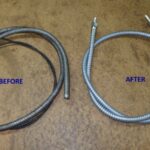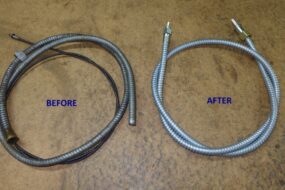Use the nut to pull the tapered stud home.
Check that any parts you are not going to replace are undamaged before ordering replacements.
Remove protective grease or other material from new parts. Compare them with the old ones to find which is left and which is right. Trying to screw on the wrong joint would damage both joint and rod.
To refit a ball joint to a track rod, grease the thread and screw the joint into place, giving it exactly the same number of turns as when the old joint was removed. Or screw it up to a mark you made earlier.
Do not tighten the locknut yet. Make sure the ball-joint stud is pointing straight up (or down, as appropriate) when in the middle of its travel, as the joint is flexed.
If not, twist the whole joint on the rod to bring the stud into line. Push the stud carefully through the bore in the steering arm.
If the stud revolves as you tighten the nut, jam it with a lever. Use a torque wrench later, for final tightening.
Fit the washer and locking nut to the stud, and tighten the nut to pull the tapered stud into the bore.
If a self-locking nut was used, replace it with a new one: a self-locking nut should not be used twice.
If the threads are stiff, the nut may make the stud turn so that it does not screw up.
Hold the stud by levering against the other side of the joint with a bar resting on the inside wheel rim.
Finish tightening the nut with a torque wrench set to the correct loading. If you cannot obtain the correct setting from a service manual or your local dealer, 25 lb ft (3.5 kg m) is about right.
If a castellated locknut is used, tighten it more, not less, to align one of its cut-outs with the hole for the split pin. Always use a new split pin. Insert it, prise it apart with a small screwdriver and bend the two halves opposite ways around the nut.
Hold the joint firmly while tightening the locknut.
Tighten a ball-joint locknut while you hold the ball joint firmly with a spanner or self-locking grips to stop it from turning. Otherwise the joint will be damaged.
Check that the toe-in or toe-out of the wheels is correct (See Adjusting toe alignment on wheels). The setting is usually given in the car handbook. This check should be done by a garage if you do not have the equipment for it.
Replacing classic Renault rods
Bolt the forked end of the outer rod to the eye of the inner rod.
When refitting the inner rod, screw it home the same number of turns as it took to remove it.
Set the eye vertical, then screw up the locknut.
When replacing a Renault non-adjustable outer rod, reconnect the ball joint as usual.
Fit the forked end of the rod to the eye of the inner rod, push the bolt home and tighten the nut.
Adjustable outer rods should be set to the right length before fitting.
When replacing an inner rod, fit the gaiter into the groove behind the head of the locknut. Screw the rod in, giving it the same number of turns as it took to remove the rod originally. Adjust until the eye is vertical, and tighten the nut. Refit the gaiter, then reconnect the outer rod.
Methods for old VW and Audis
Bolt the inner end of a long track rod to the central yoke.
When replacing a non-adjustable track rod with an adjustable one, screw the ball-joint and/or bushed end in or out, to make the rad the same length as the old one.
Ensure that the two ends are aligned before tightening the locknuts or clamps. Reconnect the outer ball joint to the steering arm in the normal way.
With a long track rod connected to a single, central rack yoke or steering-box drop arm, refix the rod to the rack yoke by refitting the locking plate (if removed), bolt, washer and nut.
Screw up to the measured distance and tighten the locknut on a short track rod.
With VW Beetle steering-box systems, reconnect the inner ball joints by the same method as the outer ones.
With the short track rod used on the VW Golf and similar cars, screw the rod on to the end of the rack until the distance between the rack-housing end and the inner face of the inner ball joint matches the measurement made earlier (measure at both rack ends).
Do not forget to slide on the gaiter and the rubber ring which fits inside it.
Tighten the locknut and refit the gaiter.







